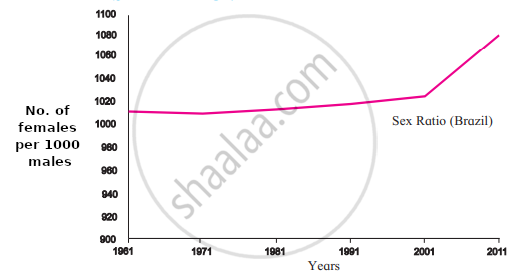Advertisements
Advertisements
प्रश्न
With the help of given statistical data prepare a simple bar graph and answer the following questions:
India – Trend of Urbanisation (1961-2011)
| Year | Percentage of Urban Population |
| 1961 | 18.0 |
| 1971 | 18.2 |
| 1981 | 23.3 |
| 1991 | 25.7 |
| 2001 | 27.8 |
| 2011 | 31.2 |
(1) What is the interval of the data?
(2) Which decade shows slow rate of urbanisation?
(3) Which decade shows high rate of urbanisation?
उत्तर

1) - The interval of the data is ten years.
2) The decade 1961 to 1971 shows slow rate of urbanisation
3) The decade 2001 and 2011 shows high rate of urbanisation.
APPEARS IN
संबंधित प्रश्न
Explain the reasons of low sex ratio in India.
Observe the following graphs and answer the questions given below them:


(1) What do the above graphs show?
(2) Which country has highest male population?
(3) Which country has highest female population?
(4) Which country has rapid increase in female population after 2001?

(5) What was the female population in India in 1961?
(6) Which country has more than 1000 female population?
Classify the factors affecting the distribution of population into favourable and unfavourable. Nearness to sea, lack of roads, temperate climate, lack of industries, new cities and towns, tropical moist forests, minerals, semi-arid climate, cultivable land.
Giving examples, correlate climate and population distribution.
Observe the following graph and answer the questions given below-
Brazil- % of population (2016)

- Which type of graph is this?
- Which age group has the highest population?
- Write class interval of age groups given on Y-axis.
- Whose number is more in males and females of age above 60?
- How much percent of females are found in age group of 55 to 59 years?
- After which age group is the decrease in population found?
Prepare a simple bar graph with the help of given statistical information and answer the questions given below-
Brazil-life expectancy
| Years | Life expectancy |
| 1960 | 54 |
| 1970 | 59 |
| 1980 | 61 |
| 1990 | 65 |
| 2000 | 70 |
| 2010 | 73 |
| 2016 | 75 |
Questions-
- What is the interval of years in the data?
- What is the difference in life expectancy of 1960 and 2016?
- Write five sentences about the analysis of graph.
With the help of given statistical data, prepare a simple bar graph and answer the following questions.
| Year | Percentage % of Urban Population in India |
| 1961 | 18.0 |
| 1971 | 18.2 |
| 1981 | 23.3 |
| 1991 | 25.7 |
| 2001 | 27.8 |
| 2011 | 31.2 |
- Mention the year m which the percentage of urban population in India was 18?
- By how many percent did the percentage of urban population increase in decade 2001 to 2011?
- In which decade was the percent growth in urban population highest?
Observe the following graph and answer the questions given below:


- What does the sex ratio of India indicate ?
- Since when has the sex ratio in India increased?
- What was the condition of sex ratio in India in 1961-71?
- What does sex ratio mean?
- What does the sex ratio of Brazil indicate?
- In which year did the women outnumber men in considerable amount in Brazil?
Is there a relationship between increase in life expectancy and growth of population? If yes, how?
If the proportion of dependent age groups increases in the composition of population, how will it affect the economy of a country?
